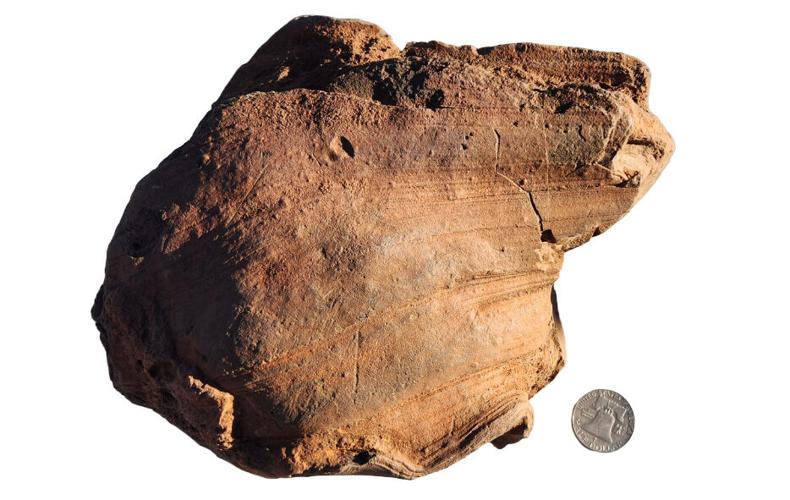Volcanoes and contact metamorphism (existing rocks exposed to magma) have played an important role in the geologic history and diverse mineral composition of Arizona.
From 1.8 billion years ago during the Precambrian Era, Arizona has a long record of volcanic activity as seen in the form of cinder cones, lava flows, calderas, domes and volcanoes originating from plate tectonics, crustal stretching and subduction.
After studying seismic waves and rock composition (elements and isotopes), seismologists determined that the heat necessary to generate volcanism in northern Arizona came from molten material circulating up from the Earth’s mantle to the crust.

Fusiform (spindle shaped) volcanic bomb from Red Mountain off Highway 180, 31 miles northwest of Flagstaff.
Several areas in and around Arizona have been noted as active volcano fields based upon estimates of future localized volcanic activity. They include the San Francisco and Uinkaret fields on the Colorado Plateau in northern Arizona along with the Pinacate field south of the Arizona/Mexico border. The San Francisco Volcanic Field consists of over 600 volcanoes averaging 1,000 feet tall created by multiple eruptions beginning 6 million years ago. Evidence of such eruptions found in the landscape includes volcanic fragments of lava containing bubbles of dissolved gas ejected several kilometers or hundreds of meters from a volcanic vent. Classified as pyroclasts that include cinders, ash and volcanic bombs, these objects were molded by airflow into saucer-like aerodynamic shapes during their travel in the air before landing on the surface.
The western third of North America, including Southern Arizona and Northern Sonora, were directly impacted by the Laramide Orogeny, a mountain building event that occurred 75 million years ago caused by continental drift contact with a volcanic zone on the Pacific floor. Heat from the Earth’s mantle caused magma to rise to the surface melting sea-floor rocks and mixing with sea water. Crustal folding and breaking induced mineral-rich solutions to reach the surface including crystallized copper deposits. Also created were gold and silver mineralization found in narrow veins of volcanic rocks while also occurring in minor amounts with porphyry copper deposits.

Volcanic bomb originating as a viscous blob of lava found near A-1 Mountain in the San Francisco Volcanic Field.
Volcanic rocks host metallic and nonmetallic ore deposits. Examples of large copper deposits in Arizona such as Ajo, Safford and San Manuel originated as heated fluids near volcanic conduits. Commercial products including perlite, cinders and lightweight high-strength aggregate pozzolans are derived from volcanic rocks. Composed of finely ground siliceous materials and mixed with water and lime, they form natural cement. Glen Canyon Dam was constructed with such pozzolan products. Pozzolan deposits in Arizona include the Sugarloaf Rhyolite Dome in the San Francisco Peaks, Kirkland Pozzolan Mine in Yavapai County, and claims near Bill Williams Mountain.
Below the Colorado Plateau, mineral deposits become more prevalent due to a history of intense faulting and igneous intrusion. Lode gold deposits have been found in epithermal, mesothermal and hypothermal veins occurring during the Tertiary age from 66 million to 2.6 million years ago. Mineralization was created by ascending thermal solutions not deeper than 3,000 feet below the surface found at the King of Arizona (Kofa Mine). Oatman (Tom Reed, United Eastern, and Gold Road veins) are noteworthy gold producers of the epithermal type found with abundant calcite and quartz along with pale-yellow particles of gold alloyed with silver. Kofa’s production along with the nearby North Star Mine included over 220,000 ounces of gold and 90,000 ounces of silver from 1897 to 1911. Both mines are consequences of volcanic events including tertiary lava flows.

Both black and white smokers were instrumental in generating early mineralization on display at the Jerome State Historic Park.
Mesothermal deposits are formed at moderate temperatures and pressures at intermediate depths from hydrothermal fluids. Mines affiliated with mesothermal veins include those in the Bradshaw (Congress & Octave Mines), Weaver, Vulture, Harquahala, Gila, Cerbat and Dos Cabezas Mountains.
Hypothermal veins distributed under high temperature and pressure are less abundant in Arizona, though a few are found in Cherry Creek Mining district, Iron King Mine and the Bradshaw Mountains. Appearance is lenticular with gold occurring in placers and in hardrock deposits through gold bearing sulfides carried by quartz.

Thumbnail specimen of vanadinite from the Western Union Mine, one of multiple deposits originating from mesothermal veins in the Cerbat Mountains, Mojave County, Arizona.

Fine grains of seam type gold from rocks mixed with hot magma (contact metamorphic) from the Old Hat Mine, Mammoth District.
The Ajo region is another area known for volcanics including the Batamote Mountains, a 20-million-year-old shield volcano near the New Cornelia ore body, a porphyry copper deposit created by a tertiary intrusion. Copper ores chalcocite, malachite and chrysocolla are found at the surface with chalcopyrite and bornite occurring further below.
Southeastern Arizona has a noted volcanic history including the Santa Rita Mountains and the Tombstone Hills. Hydrothermal (hot water) solutions containing dissolved gases and solids, mixed with water flowing through fractures in crustal rock, formed the silver and lead minerals mined for profit at these sites since the late 19th century.
The copper mines of Jerome formed by Precambrian volcanism originated from below the ocean. Jerome-type massive sulfide deposits precipitated from sea floor hot spring vents as evidenced by both black and white smokers found at the U.V.X. Mine.
Geology is not static. The movement of Earth’s plates through subduction, faulting and volcanism followed by erosional forces and exposure to hydrothermal solutions will continue to shape Arizona’s landscape through the progression of time, creating more mineral laden deposits.
Do you know Arizona's state bird or its state mammal? Take this quiz and see how you do. Video by Johanna Eubank, Arizona Daily Star










